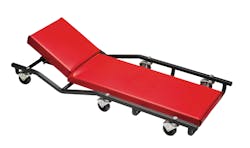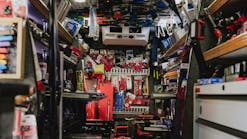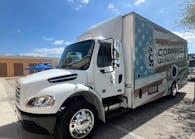Working under the vehicle can be difficult and tedious for technicians. Without proper equipment, under vehicle work or body work can require technicians to spend long hours standing, bending, kneeling or crawling. This increases strain on the technician, which can lead to work-related injury. It is also fatiguing and can decrease technician productivity.
Particularly in shops that don’t use overhead lifts, having well-made creepers and seats can allow technicians to work comfortably and improve their productivity.
“Creepers are beneficial when technicians need to do work underneath a vehicle,” says Eddie Lisle, assistant sales manager, Lisle Corporation. "Seats come in handy when completing brake, tire service and body work.”
Lisle specializes in specialty automotive tools, mechanic’s creepers and lubrication and tire products.
Demonstrating quality creepers and seats with features that address the problems technicians are currently living with can create more sales opportunities with both newer technicians who don’t already own a creeper or seat, and veterans in the industry looking for an upgrade.
Offering the right fit for the job
As with any tool or equipment, the best solution depends on application. Technicians can use a variety of criteria for determining the proper seat or creeper for them.
“A good caster will save [techs] a lot of headache,” says Angie Thompson, national sales and marketing manager, Whiteside Manufacturing.
Whiteside Manufacturing has specialized in innovative creepers and seats for 50 years.
- Length. Does the creeper fit the technician’s body type? Creepers should be long enough to support the body from head to rear. The average creeper length is 36” to 40”. Taller technicians may need to consider looking for longer creepers.
- Accessories. Some creepers have guards over the wheels to keep clothing from getting caught in the wheels. Others have wheel locks for getting on and off the creeper, and many seats have built-in tool trays.
Lisle adds that it is also important to remember that a shop environment requires creepers and seats to be durable and easy to clean.
“It is beneficial to have [a creeper or seat] that is resistant to solvents, greases and fuels,” he says.
Product Trends
A major focus in creepers and seats right now is improving the quality of the wheels. A creeper or seat that doesn’t roll well is not useful to technicians. Older creepers and seats had steel wheels that bolted directly to the frame with a small axle. These wheels are very durable, but they tend to get stuck on cracks or pebbles frequently.
More recently, Lisle says, creeper and seat manufacturers have begun using urethane wheels with ball bearings. These wheels are just as durable, but a lot more functional. Wheel guards are also becoming increasingly common. These guards prevent the technician’s clothes from getting caught in the wheels of the creeper during use.
Erik Sieb, president, Creepex, says the company identified a common complaint with most creepers: trouble overcoming obstacles such as extension cords, zip ties or even dirt.
“We designed patented creepers with six 7” wheels that are slightly slanted on a 10-degree inwards angle,” Sieb says. “The way these larger wheels are positioned against the body of the mechanic makes our creepers glide easier. It also improves push and pull torque for technicians by eliminating sideways movement. Moving sideways basically creates an uncontrollable creeper.”
Creepex makes specialized creepers that address the problems technicians commonly have with creepers.
Improving technician safety is another concern.
Creepex, for example, offers a creeper with a built-in body guard that will help protect the technician and reduce injuries in case a vehicle shifts or a part falls after dissembling it.
“Our body guard will withstand 30,000 lbs, or the equivalent of 10 cars,” Sieb says.
Body guards like this help to limit the risk of injury to technicians who frequently work under the vehicle dissembling heavy parts.
“Improving comfort is also a concern,” adds Lisle.
Instead of being perfectly flat with just a head rest, many newer creepers feature ergonomically designed plastic that molds to the body. These are both durable and designed to be comfortable. Others are foam padded with adjustable headrests for additional support and comfort.
Instead of being one-size-fits-all, most creepers are now built for a variety of body types. This means that creepers are being built longer with larger weight capacities, and in both wider and longer styles, so that technicians can choose a creeper that will be comfortable for them. They are also available in various colors, and some have built-in storage space that is handy for keeping commonly used tools nearby when working on the vehicle.
Effective Selling
Technicians want to buy equipment that has a demonstrated value for them. If they can see how the product will save them time and effort, they will be more likely to buy it.
“It’s helpful to know what kind of environment they’re working in and what type of work they are doing – such as brake work, engine work or under the dash work,” says Thompson of Whiteside Manufacturing. “We have specific products targeted to each use.”
“Really, the main question to ask is, ‘What’s your problem or pain?’” adds Creepex’s Sieb. “Then, help them find a product that overcomes that issue at a reasonable price.”
It’s hard to explain the benefits of a particular creeper or seat without actually showing it to the customer, Sieb notes. The best way to illustrate its advantages is to keep it on the truck and let them try it. Let the customers see for themselves how easy it is to use, and let them get a feel for what the product can offer them.
If there’s not enough space on the truck to store a few different options, showing a video is the next best option. This allows customers to see how the product can be used and what features make it different from other creepers or seats they may have tried and not liked.
“[Demonstrating] is always a good option,” Thompson says. “Task-specific products such as Whiteside’s over-the-engine creeper or under-the-dash creeper are best shown in use, as looking at just an image of the product can be a bit confusing to the user.”
Seeing the product in use helps people understand the functionality of the product.
Lisle suggests that creepers with a bright and unique color can attract attention, making them a good choice for displaying. For distributors with limited space on the trucks, he suggests displaying a low-profile model of creeper.
“This will convey the maximum amount of vehicle accessibility,” he says, and adds that it is smaller and less bulky than other creepers and seats.
Summary
There is a continuing need for automotive creepers and seats that allow technicians to easily maneuver while working on various parts of a vehicle. They provide a more comfortable working environment for technicians and allow them to work more effectively.
“Ask them if it would be beneficial to have an efficient way to work comfortably under a vehicle,” Lisle advises.
Keep an eye out for shops that do not use overhead lifts, as these technicians will benefit from using creepers and seats.
Ask customers about some of their current problems and pains when working on or under the vehicle, and then help them find a creeper or seat that can minimize or eliminate the issue. Technician feedback is a great resource. Technicians know what they need – and what has worked and what hasn’t. They will be likely to buy quality products that can help them address those needs.



